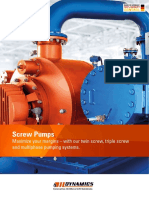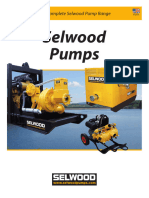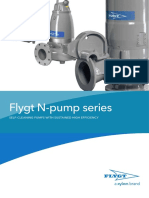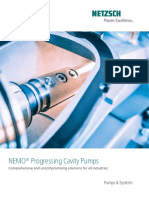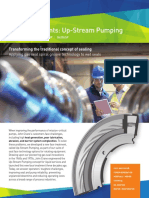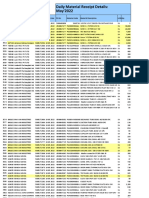How Peristaltic Pump Works
How Peristaltic Pump Works
Uploaded by
instrutechCopyright:
Available Formats
How Peristaltic Pump Works
How Peristaltic Pump Works
Uploaded by
instrutechOriginal Description:
Copyright
Available Formats
Share this document
Did you find this document useful?
Is this content inappropriate?
Copyright:
Available Formats
How Peristaltic Pump Works
How Peristaltic Pump Works
Uploaded by
instrutechCopyright:
Available Formats
The UKs leading pump specialist since 1971
michael smith engineers ltd for difficult liquid handling applications
How a
Peristaltic
Pump works
Freephone 0800 3167891 info@michael-smith-engineers.co.uk www.michael-smith-engineers.co.uk
The UKs leading pump specialist since 1971
michael smith engineers ltd for difficult liquid handling applications
Peristaltic Principle
The tubing is fixed between the tube-bed and the rotor
at each roller location the tubing is squeezed
position A, B and C
The rollers on the revolving rotor move across the
tubing
the tubing is continuously squeezed by the rollers which
push the liquid in the direction of the revolving rotor
The tubing behind the rollers recovers its shape,
creates a vacuum and draws liquid in behind it.
Freephone 0800 3167891 info@michael-smith-engineers.co.uk www.michael-smith-engineers.co.uk
The UKs leading pump specialist since 1971
michael smith engineers ltd for difficult liquid handling applications
Peristaltic Principle
A pillow of liquid is formed between the
rollers
the pillow is the pump chamber and
determines the volume per roller step and,
hence, the flow rate
the pillow volume not only depends on the
inner diameter (i.d.) of the tubing, but also
on the tubing properties, the drive and
pump-head specifications as well as the
liquid and the physical application
conditions
Freephone 0800 3167891 info@michael-smith-engineers.co.uk www.michael-smith-engineers.co.uk
The UKs leading pump specialist since 1971
michael smith engineers ltd for difficult liquid handling applications
Roller-step volume
The pillow volume determines the roller-step
volume which depends on:
Pump system Tubing
number of rollers inner diameter
pump-head design wall thickness
- e.g. spring-loaded tube-bed formulation
occlusion setting age of tubing
rotation speed
Liquid Application conditions
type of liquid suction lift / vacuum
temperature differential pressure
viscosity
Freephone 0800 3167891 info@michael-smith-engineers.co.uk www.michael-smith-engineers.co.uk
The UKs leading pump specialist since 1971
michael smith engineers ltd for difficult liquid handling applications
Flow rate
The flow rate is calculated as follows:
Volume per roller step (pillow volume)
x Number of rollers
= Volume per revolution
Volume per revolution
x Rotation speed per minute
= Flow rate per minute
Freephone 0800 3167891 info@michael-smith-engineers.co.uk www.michael-smith-engineers.co.uk
The UKs leading pump specialist since 1971
michael smith engineers ltd for difficult liquid handling applications
Advantages
no contact of the liquid with mechanical parts
tube is only part to wear
service and maintenance costs are minimal
easy to clean and sanitize
multi-channel systems available
Ismatec pumps available up to 24 channels
insensitive to dry-running
Freephone 0800 3167891 info@michael-smith-engineers.co.uk www.michael-smith-engineers.co.uk
The UKs leading pump specialist since 1971
michael smith engineers ltd for difficult liquid handling applications
Advantages
self-priming
excellent suction height
use tubing with small i.d., thick wall and stiff material
no siphoning effect when pump is stopped
immune to many chemicals
depends on the tubing material
suspensions and sludge can be pumped
with a solid content of up to 60%
Freephone 0800 3167891 info@michael-smith-engineers.co.uk www.michael-smith-engineers.co.uk
The UKs leading pump specialist since 1971
michael smith engineers ltd for difficult liquid handling applications
Advantages
virtually immune to abrasive media
liquids of high viscosity can be delivered
gentle delivery due to very low shearing forces
ideal for delicate suspensions
e.g. blood cells or bio-technological media are not damaged
some tubing material can be autoclaved
very high repeatability - suitable for auto-analyzers
pumps system must be calibrated
Freephone 0800 3167891 info@michael-smith-engineers.co.uk www.michael-smith-engineers.co.uk
The UKs leading pump specialist since 1971
michael smith engineers ltd for difficult liquid handling applications
Limitations
chemical inertness
depends on the tubing material
slight pulsation is inevitable
tubing requires recalibrating and changing
due to wear
at certain intervals depending on the application
very important for accurate and repeatable pumping
more frequently in comparison to gear and piston pumps
tubing may leak after extensive use
Freephone 0800 3167891 info@michael-smith-engineers.co.uk www.michael-smith-engineers.co.uk
The UKs leading pump specialist since 1971
michael smith engineers ltd for difficult liquid handling applications
Limitations
depending on the pump-head system the flow
rate is sensitive to varying differential pressure
conditions (all spring-loaded tube-beds!)
accuracy and repeatability of the flow rate also
depend on the tubing age and material used
max. differential pressure is lower in comparison
to gear and piston pumps
depends very much on tubing material and inner diameter
in relation to wall thickness
Freephone 0800 3167891 info@michael-smith-engineers.co.uk www.michael-smith-engineers.co.uk
The UKs leading pump specialist since 1971
michael smith engineers ltd for difficult liquid handling applications
Tubing size
The tubing is the pump chamber of the peristaltic
pump and, hence, one of the most important parts !
The following tubing specifications have particular
effects on the pumping process:
inner diameter (ID)
wall thickness (WT)
material (formulation)
Different combinations of these parameters change the
pumping behavior and consequently lead to different
results.
Freephone 0800 3167891 info@michael-smith-engineers.co.uk www.michael-smith-engineers.co.uk
The UKs leading pump specialist since 1971
michael smith engineers ltd for difficult liquid handling applications
Tubing Life
Life expectancy of the tubing depends on the
following features:
tubing material
drive speed
number of rollers
operating temperature
pressure conditions
liquid used
chemical composition, particles, etc
tube-bed and roller design
Ismatec catalogue provides overview of approximate
tubing life
Freephone 0800 3167891 info@michael-smith-engineers.co.uk www.michael-smith-engineers.co.uk
You might also like
- T Rex PumpDocument4 pagesT Rex PumpWong DaNo ratings yet
- Vacuum DryerDocument5 pagesVacuum DryerinstrutechNo ratings yet
- Vacuum DryerDocument5 pagesVacuum DryerinstrutechNo ratings yet
- KSB Borehole LiteratureDocument24 pagesKSB Borehole LiteratureSudip LamsalNo ratings yet
- CRI PumpsDocument13 pagesCRI Pumpscrigroups0% (1)
- Wemco Product OverviewDocument24 pagesWemco Product OverviewAkilesh AravindakshanNo ratings yet
- Brochure PAS and VAR PumpsDocument16 pagesBrochure PAS and VAR PumpsSmatt FredNo ratings yet
- Screw Pumps: Maximize Your Margins - With Our Twin Screw, Triple Screw and Multiphase Pumping SystemsDocument12 pagesScrew Pumps: Maximize Your Margins - With Our Twin Screw, Triple Screw and Multiphase Pumping SystemsKykyRizkyNo ratings yet
- PCM Brochure Mining and Minerals enDocument7 pagesPCM Brochure Mining and Minerals enAnonymous ItzBhUGoiNo ratings yet
- MBN - E00657 Multistage Pump PDFDocument8 pagesMBN - E00657 Multistage Pump PDFAlfonso BlancoNo ratings yet
- PK1024-MKF-MDB060-365097 01Document9 pagesPK1024-MKF-MDB060-365097 01waqas_a_shaikh4348No ratings yet
- Submersible Pumps Brochure en Aug20Document10 pagesSubmersible Pumps Brochure en Aug20Karina MedinaNo ratings yet
- Ensol GULLY/ VACUUM /CESSPIT - EMPTIER/ VACUUM SUCKERDocument3 pagesEnsol GULLY/ VACUUM /CESSPIT - EMPTIER/ VACUUM SUCKERajay7822No ratings yet
- Selwood Complete BrochureDocument8 pagesSelwood Complete BrochureRicky PradanaNo ratings yet
- Tractor Design & Testing - Lesson 17. Hydraulic System Design ConsiderationsDocument3 pagesTractor Design & Testing - Lesson 17. Hydraulic System Design ConsiderationsCaio GiarettaNo ratings yet
- Industrial Report (PSG)Document21 pagesIndustrial Report (PSG)Ratna PadaviNo ratings yet
- Introduction To Pumps - The Process PipingDocument10 pagesIntroduction To Pumps - The Process Pipingميلاد الفرجانيNo ratings yet
- Rigid PVC Pressure Pipes and Fittings: ... The Most Comprehensive Range With A Wide Spectrum of FittingsDocument2 pagesRigid PVC Pressure Pipes and Fittings: ... The Most Comprehensive Range With A Wide Spectrum of Fittingsarjun 11No ratings yet
- B HighHead IS115-ADocument2 pagesB HighHead IS115-AJOHNNY CALERONo ratings yet
- High Pressure Plumbing System Upvc: ... The Easy and Economical SolutionDocument2 pagesHigh Pressure Plumbing System Upvc: ... The Easy and Economical Solutionarjun 11No ratings yet
- In-Plant Pump Station PDFDocument9 pagesIn-Plant Pump Station PDFAndrés BahamondeNo ratings yet
- Flygt N SeriesDocument16 pagesFlygt N SeriesPeter PetnýNo ratings yet
- Unit-5 AeDocument45 pagesUnit-5 Aebaaskararcher506No ratings yet
- An Week4Document24 pagesAn Week4Tania NoorNo ratings yet
- 6 - Bombas - Curva - 2018Document51 pages6 - Bombas - Curva - 2018Jack Chancahuaña MamaniNo ratings yet
- AED1E2Document14 pagesAED1E2uslugiitcswNo ratings yet
- Hidrostal Oily Water Applications Bro SPDocument8 pagesHidrostal Oily Water Applications Bro SPRamiro CardenasNo ratings yet
- GRI Compact Bellows Pumps Overview 0222Document14 pagesGRI Compact Bellows Pumps Overview 0222Andre PauloNo ratings yet
- Design of Sewerage SystemDocument51 pagesDesign of Sewerage SystemShiela SorinoNo ratings yet
- 5.flexible Pipe CatalogueDocument8 pages5.flexible Pipe CatalogueIwan KurniawanNo ratings yet
- Brochure General Big BredelDocument12 pagesBrochure General Big BredelwilfredoruizNo ratings yet
- WSP Series Self Priming PumpsDocument1 pageWSP Series Self Priming PumpsabmopalhvacNo ratings yet
- Small Pumps Summary Sheet English PDFDocument2 pagesSmall Pumps Summary Sheet English PDFRyan DuhonNo ratings yet
- Checkball Pump BenfitsDocument2 pagesCheckball Pump BenfitsMurtaza AliNo ratings yet
- Hydraulic Pumps & MotorsDocument11 pagesHydraulic Pumps & Motorsshormanb21No ratings yet
- Hydraulic PumpsDocument54 pagesHydraulic PumpsPraveen Bavana100% (1)
- Diffusion Pump Typical ApplicationsDocument1 pageDiffusion Pump Typical Applicationsanon_949725449No ratings yet
- MBH All Product & Corporate - CatalogueDocument5 pagesMBH All Product & Corporate - CataloguenewprojectaceNo ratings yet
- Shrimp Farming ETECDocument4 pagesShrimp Farming ETECGerardo RodriguezNo ratings yet
- Fluid Flow Note Chapter 7Document57 pagesFluid Flow Note Chapter 7Fareez IzwanNo ratings yet
- Session 6 - Mechanical Seals and Sealing Systems: Specialist For Pumping TechnologyDocument48 pagesSession 6 - Mechanical Seals and Sealing Systems: Specialist For Pumping TechnologyYay ChanNo ratings yet
- Dcb20053-Plumbing Services Topic4: Drainage SystemDocument39 pagesDcb20053-Plumbing Services Topic4: Drainage SystemzarinamatsapriNo ratings yet
- NETZSCH Progressing Cavity Pumps - 12 - 19Document28 pagesNETZSCH Progressing Cavity Pumps - 12 - 19johnjoviedoNo ratings yet
- NETZSCH NEMO® Progressing Cavity Pumps ENDocument28 pagesNETZSCH NEMO® Progressing Cavity Pumps ENEduuNo ratings yet
- Dow Product Profile Data PDFDocument24 pagesDow Product Profile Data PDFsrikanta pradhanNo ratings yet
- Tapflo PumpssDocument17 pagesTapflo PumpssDo SubscribeNo ratings yet
- John Crane-Up-Stream-Pumping-BrochureDocument3 pagesJohn Crane-Up-Stream-Pumping-BrochureManuel GarciaNo ratings yet
- Centrifugal Pump Without Bearings or Seals - EDTDocument4 pagesCentrifugal Pump Without Bearings or Seals - EDTCarlos CuadradoNo ratings yet
- Corodex Electro Mechanic - Company ProfileDocument24 pagesCorodex Electro Mechanic - Company ProfileOsama EssamNo ratings yet
- Dynexselection PDFDocument19 pagesDynexselection PDFMisael CastilloNo ratings yet
- Pumps Motors: Company ProfileDocument8 pagesPumps Motors: Company ProfilePradeep KumarNo ratings yet
- ChokesBrochure ENG v01Document12 pagesChokesBrochure ENG v01ermaiezNo ratings yet
- Folleto TechniFlo Nueva Version 2Document16 pagesFolleto TechniFlo Nueva Version 2juan pablo suarezNo ratings yet
- Pump Selection GuideDocument2 pagesPump Selection Guidem_najmanNo ratings yet
- 01 RasmussenDocument14 pages01 RasmussenHmidaNo ratings yet
- NETZSCH NEMO® Progressing Cavity Pumps ENDocument28 pagesNETZSCH NEMO® Progressing Cavity Pumps ENjeremy jandaNo ratings yet
- Flygt Propeller PumpDocument16 pagesFlygt Propeller PumpIrpan Fauzy Harahap100% (1)
- Wemco HidrostalDocument12 pagesWemco HidrostalFABIO DALAGNOLONo ratings yet
- Severe Service Ball Valves For High Pressure Slurry PipelinesDocument7 pagesSevere Service Ball Valves For High Pressure Slurry PipelinesCesar YalanNo ratings yet
- Three Screw Pump (Ky Pump)Document4 pagesThree Screw Pump (Ky Pump)Raso DasicNo ratings yet
- BOMBAS NMO BY - Progressing-Cavity-Pumps - 1120Document8 pagesBOMBAS NMO BY - Progressing-Cavity-Pumps - 1120Diego Fernando Cabal CasanovaNo ratings yet
- Sewage Disposal Works: Their Design and ConstructionFrom EverandSewage Disposal Works: Their Design and ConstructionNo ratings yet
- Instruction Manual.: Set UpDocument1 pageInstruction Manual.: Set UpinstrutechNo ratings yet
- Fluid MechanicsDocument3 pagesFluid MechanicsinstrutechNo ratings yet
- Mixing and Agitation: Instruction ManualDocument3 pagesMixing and Agitation: Instruction ManualinstrutechNo ratings yet
- Evaporator DataDocument1 pageEvaporator DatainstrutechNo ratings yet
- Calibration of Bimettalic Thermometer: Instru-Tech, PuneDocument1 pageCalibration of Bimettalic Thermometer: Instru-Tech, PuneinstrutechNo ratings yet
- Bimettalic ThermometerDocument4 pagesBimettalic ThermometerinstrutechNo ratings yet
- Sr. No. Volume of Filtrate, V - CM Time Taken T, Sec. V, CM T, Sec. T/ V. Sec/cm 1 2 3 4 5 6Document1 pageSr. No. Volume of Filtrate, V - CM Time Taken T, Sec. V, CM T, Sec. T/ V. Sec/cm 1 2 3 4 5 6instrutechNo ratings yet
- Nanofluid Heat TransferDocument1 pageNanofluid Heat TransferinstrutechNo ratings yet
- Dynamic Thermal Conductivity Measurement of Nanofluids.: OutletDocument1 pageDynamic Thermal Conductivity Measurement of Nanofluids.: OutletinstrutechNo ratings yet
- Plug Flow Reactor: S.S.304 .: Feed TankDocument1 pagePlug Flow Reactor: S.S.304 .: Feed TankinstrutechNo ratings yet
- Steam Generator - 10 Kg/hr. Heat Transfer Area of Each Evaporator: 0.791 M - Heat Transfer Area of Condenser: 0.527 M - Temp Sensor LocationsDocument1 pageSteam Generator - 10 Kg/hr. Heat Transfer Area of Each Evaporator: 0.791 M - Heat Transfer Area of Condenser: 0.527 M - Temp Sensor LocationsinstrutechNo ratings yet
- Column Diameter and Pressure Drop GraphDocument4 pagesColumn Diameter and Pressure Drop GraphinstrutechNo ratings yet
- Simple DistillationDocument5 pagesSimple DistillationinstrutechNo ratings yet
- Shell and Tube Heat Exchanger User's ManualDocument5 pagesShell and Tube Heat Exchanger User's ManualinstrutechNo ratings yet
- Froth Floatation CellDocument3 pagesFroth Floatation CellinstrutechNo ratings yet
- CentrifugeDocument4 pagesCentrifugeinstrutechNo ratings yet
- Sieve Shaker: Instruction ManualDocument4 pagesSieve Shaker: Instruction ManualinstrutechNo ratings yet
- Cooling TowerDocument11 pagesCooling TowerinstrutechNo ratings yet
- Choked FlowDocument3 pagesChoked Flowbzkizo_sbbNo ratings yet
- Fisher Isotemp Refrigerated Heated Bath CirculatorsDocument130 pagesFisher Isotemp Refrigerated Heated Bath CirculatorsMohammad Mahdi FadaeeNo ratings yet
- Model Name - Flashd Flash Drum Flash Drum (Function) : Vapor Phase Product Liquid Phase Feed 3 Vapor Phase FeedDocument12 pagesModel Name - Flashd Flash Drum Flash Drum (Function) : Vapor Phase Product Liquid Phase Feed 3 Vapor Phase FeedamlhrdsNo ratings yet
- Alfa Laval - M15K U-TurnDocument4 pagesAlfa Laval - M15K U-TurnrezarossNo ratings yet
- Saet 8 BDocument3 pagesSaet 8 BnaefmubarakNo ratings yet
- Fire Sprinkler System NFPA 13 Plan Review ChecklistDocument10 pagesFire Sprinkler System NFPA 13 Plan Review ChecklistTanveer Aziz100% (2)
- Mnual Compressor Parafuso 06NADocument33 pagesMnual Compressor Parafuso 06NADeco Dluxe100% (4)
- Pipe Class and Piping Specifications - Must Know of Pipe For EngineerDocument45 pagesPipe Class and Piping Specifications - Must Know of Pipe For EngineerjannsinkyNo ratings yet
- Solutions For 4.5 4.6 4.7 4.16 4.18 4.21 4.33 and 4.35Document5 pagesSolutions For 4.5 4.6 4.7 4.16 4.18 4.21 4.33 and 4.35Anonymous 62sYgZ6Tp50% (2)
- FM Data Sheet CompressorsDocument14 pagesFM Data Sheet Compressorsralph1949No ratings yet
- FilmTec ManualDocument205 pagesFilmTec ManualSarmad Hameed100% (1)
- CWC-BookletF1 29 PDFDocument1 pageCWC-BookletF1 29 PDFJagannath SahuNo ratings yet
- Daily Material Receipt Details: May'2022: Voltas Limited Upbg PantnagarDocument17 pagesDaily Material Receipt Details: May'2022: Voltas Limited Upbg PantnagarMohar Singh/UPBG/PantnagarNo ratings yet
- WHA Sizing Guide PDFDocument1 pageWHA Sizing Guide PDFMohammedNo ratings yet
- Septic Vault Detail: Vicinity MapDocument1 pageSeptic Vault Detail: Vicinity Mapysog808No ratings yet
- Piping Class - GS20Document3 pagesPiping Class - GS20Dmitriy RybakovNo ratings yet
- Water Cooler Day 4-3Document10 pagesWater Cooler Day 4-3Laka 98No ratings yet
- General Notes:: Device Id and Symbol Legend ComponentsDocument21 pagesGeneral Notes:: Device Id and Symbol Legend ComponentsVU ingenieriaNo ratings yet
- Concepts For Efficient Hydrogen LiquefactionDocument16 pagesConcepts For Efficient Hydrogen LiquefactionDilla WahabNo ratings yet
- Lecture 1.2: Overview of The CFD Process and Workflow: ANSYS Fluent Getting Started - Part 1Document15 pagesLecture 1.2: Overview of The CFD Process and Workflow: ANSYS Fluent Getting Started - Part 1Rafael MunguíaNo ratings yet
- BITS Pilani: Scale-Up of High-Shear Mixer GranulatorsDocument12 pagesBITS Pilani: Scale-Up of High-Shear Mixer GranulatorsshrikantmsdNo ratings yet
- Materials: Pressure Parts and Applicable Service TemperaturesDocument14 pagesMaterials: Pressure Parts and Applicable Service Temperaturesmohan babuNo ratings yet
- Fluid DynamicsDocument14 pagesFluid DynamicsBabylyn AustriaNo ratings yet
- Theory Exercise 20/100Document2 pagesTheory Exercise 20/100sanower.rehmanNo ratings yet
- Sakshi C February 13 PDFDocument12 pagesSakshi C February 13 PDFSakshi JainNo ratings yet
- Saes L 100Document13 pagesSaes L 100Honesto Bautista100% (3)
- FlowSafe F70PR BulletinDocument16 pagesFlowSafe F70PR BulletinbernabasNo ratings yet
- Tutorial 1 Mekanika Fluida MS3121-03Document3 pagesTutorial 1 Mekanika Fluida MS3121-03adri fathudienNo ratings yet
- Week4 - Solved TutorialDocument9 pagesWeek4 - Solved TutorialRudra Sai SandeepNo ratings yet
- Petronas Technical Standards: Separator Modelling TechniquesDocument26 pagesPetronas Technical Standards: Separator Modelling Techniquesahmadreza777No ratings yet






